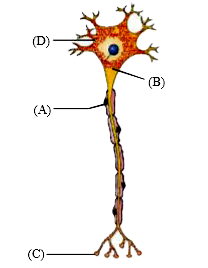Choose the correct alternative (a), (b), (c) or (d) for each of the questions given below :
The distance between successive nodes and anti-nodes is :
The correct Answer is:C
To solve the question regarding the distance between successive nodes and anti-nodes, we can break it down into clear steps:
Step 1: Understanding Nodes and Anti-nodes
- In a standing wave, nodes are points where the wave has minimum amplitude (displacement is zero), and anti-nodes are points where the amplitude is maximum (displacement is maximum).
- Nodes are typically represented at odd points (1, 3, 5, ...) and anti-nodes at even points (2, 4, 6, ...).
Step 2: Visualizing the Wave
- Let's visualize a standing wave. If we label the nodes and anti-nodes:
- Node 1 (N1)
- Anti-node 2 (A2)
- Node 3 (N3)
- Anti-node 4 (A4)
- Node 5 (N5)
- Anti-node 6 (A6)
Step 3: Distance Between Nodes and Anti-nodes
- The distance between two successive nodes (e.g., N1 and N3) is equal to half the wavelength (λ/2).
- The distance between two successive anti-nodes (e.g., A2 and A4) is also equal to half the wavelength (λ/2).
- The distance between a node and the nearest anti-node (e.g., N1 and A2) is equal to one-quarter of the wavelength (λ/4).
Step 4: Conclusion
- Therefore, the distance between successive nodes (N1 to N3) is λ/2, and the distance between successive anti-nodes (A2 to A4) is also λ/2.
- The distance between a node and the nearest anti-node (N1 to A2) is λ/4.
Final Answer
- The distance between successive nodes and anti-nodes is λ/4.
- In a standing wave, nodes are points where the wave has minimum amplitude (displacement is zero), and anti-nodes are points where the amplitude is maximum (displacement is maximum).
- Nodes are typically represented at odd points (1, 3, 5, ...) and anti-nodes at even points (2, 4, 6, ...).
- Let's visualize a standing wave. If we label the nodes and anti-nodes:
- Node 1 (N1)
- Anti-node 2 (A2)
- Node 3 (N3)
- Anti-node 4 (A4)
- Node 5 (N5)
- Anti-node 6 (A6)
- The distance between two successive nodes (e.g., N1 and N3) is equal to half the wavelength (λ/2).
- The distance between two successive anti-nodes (e.g., A2 and A4) is also equal to half the wavelength (λ/2).
- The distance between a node and the nearest anti-node (e.g., N1 and A2) is equal to one-quarter of the wavelength (λ/4).
- Therefore, the distance between successive nodes (N1 to N3) is λ/2, and the distance between successive anti-nodes (A2 to A4) is also λ/2.
- The distance between a node and the nearest anti-node (N1 to A2) is λ/4.
- The distance between successive nodes and anti-nodes is λ/4.
Topper's Solved these Questions
- SAMPLE QUESTION PAPER - 01 Book:ICSEChapter:SAMPLE QUESTION PAPER - 01 Exercise:SECTION - B
Explore 14 Videos
- SAMPLE QUESTION PAPER - 01 Book:ICSEChapter:SAMPLE QUESTION PAPER - 01 Exercise:SECTION - C
Explore 14 Videos
- PROPERTIES OF MATTERBook:ICSEChapter:PROPERTIES OF MATTERExercise:MODULE 4 ( TEMPERATURE ) UNSOLVED PROBLEMS
Explore 12 Videos
- SAMPLE QUESTION PAPER 4Book:ICSEChapter:SAMPLE QUESTION PAPER 4Exercise:SECTION - D (Answer all questions.)
Explore 7 Videos
Similar Questions
Knowledge Check
Choose the correct alternative (a), (b), (c) or (d) for each of the questions given below :
In a nuclear reactor, cadmium rods are used as :AControl rodsBFuel rodsCCoolantDModeratorChoose the correct alternative (a), (b), (c) or (d) for each of the questions given below :
Which of the following is not a unit of time ?Alight yearBns (nano second)Cμs (micro second)DminutesChoose the correct alternative (a), (b), (c) or (d) for each of the questions given below :
In an Astronomical Telescope of Refracting type :AObjective should have small focal lengthBObjective should have large focal lengthCEyepiece should have large focal lengthDBoth objective and eyepiece should have large focal length
Choose the correct alternative (a), (b), (c) or (d) for each of the questions given below :
A copper and a steel wire having same length and diameter are joined end-to-end. When a force is applied at the end of the wire, the net length of the wire increases by 1 cm. The wires will have :
View SolutionChoose the correct alternative (a), (b), (c) or (d) for each of the questions given below :
Curie temperature is the temperature above which :
View SolutionChoose the correct alternative (a), (b), (c) or (d) for each of the questions given below :
A point charge .q. is kept at each of the vertices of an equilateral triangle having each side .a.. Potential energy is
View SolutionChoose the correct alternative (a), (b), (c) or (d) for each of the questions given below :
For an adiabatic change of a perfect gas the relation between pressure and volume is :
View SolutionChoose the correct alternative (a), (b), (c) or (d) for each of the questions given below :
Which of the following is approximately the rate of solar energy (in KW) falling per m2 on the surface area of the earth ?
View Solution

